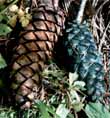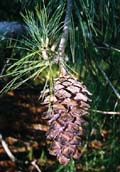 Two cones from a tree in Jiuzhaigou Forest Preserve in Sichuan. Cone on left is about 25 cm long [C.J. Earle, 9-Oct-1988].  Cone and foliage on an ornamental tree in Seattle (USA) [C.J. Earle, 20-Mar-1999]. | Pinus armandii Franchet 1884Common NamesTaxonomic notesSyn: P. dabeshanensis, P. masteriana. One variety, masteriana. P. amamiana was formerly described as a variety of P. armandii.Description"A large tree. Leaves 5 in a fascicle, slender, 8-15 cm. long, serrulate, bright green, triangular in cross section, with 1 vascular bundle and 3 resin ducts, one medial, two marginal. Mature cones ovoid, about 14 cm. long, scales rhombic, thickened, umbo terminal, unbrmed. Seed ovoid, wingless. Trunk bark blackish brown to grayish red brown, shallowly cracked or sometimes irregularly fussured, covered by thin, loosely appressed small scales (the bark on young stems grayish brown, thin and smooth); lenticels inconspicuous, outer bark about 8 mm. thick, cross section of outer bark grayish brown, with pale apricot yellow tiered streaks; phelloderm almost inconspicuous; inner bark 8-l5 mm. thick, pale reddish white, finely fibrous; cambium and newly formed phloem inconspicuous. Freshly cut sapwood pale yellowish white, wood rays inconspicuous, excreting colorless resin after cutting" (2).RangeCentral and W China, S Japan. N & C Taiwan at altitudes of 2,300-3,000 m (2).Big TreeOldestDendrochronologyEthnobotanyObservationsHave seen around Jiuzhaigou Forest Park, Sichuan (China).RemarksCitations(1) Silba 1986.(2) Liu 1970. |
[Pinus] [Pinaceae] [home] This page is from the Gymnosperm Database |